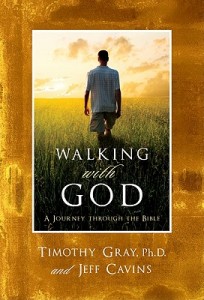 Yesterday, I featured some excerpts of my “Christopher Closeup” interview with Scripture scholar Dr. Tim Gray who co-authored a book with Jeff Cavins called “Walking with God: A Journey Through the Bible.” It uses the latest Biblical scholarship to analyze both the Old and New Testaments. Dr. Gray addressed some commonly asked questions, some of which are excerpted below including 1) Does Eve being created from Adam’s rib mean that the Bible is saying women are inferior to men? and 2) Why does God ask Abraham to sacrifice Isaac?
Yesterday, I featured some excerpts of my “Christopher Closeup” interview with Scripture scholar Dr. Tim Gray who co-authored a book with Jeff Cavins called “Walking with God: A Journey Through the Bible.” It uses the latest Biblical scholarship to analyze both the Old and New Testaments. Dr. Gray addressed some commonly asked questions, some of which are excerpted below including 1) Does Eve being created from Adam’s rib mean that the Bible is saying women are inferior to men? and 2) Why does God ask Abraham to sacrifice Isaac?
TR: Another common misconception people have from the Old Testament is that Genesis sets up a template in which women are somehow inferior to men because of the way Eve was created. You contradict that notion in the book so talk a little about that.
Tim Gray: It’s a beautiful story in Genesis 2 where God creates Eve. God puts Adam to sleep and takes a rib out of his side. There’s a beautiful old rabbinic quote that says, “God didn’t take Eve from Adam’s foot that she should be under him, or from his head that she should be above him, but from a rib so that she should be beside him, close to his heart.” The Biblical story gives such a dignity to women that you don’t find in most ancient cultures.
TR: One of the many eye-openers for me in the book is your evaluation of the story of God telling Abraham to kill Isaac, his only son, as a sacrifice. It’s a story that never fully made sense to me until I read how you related it to the story that comes before it about Abraham sending his illegitimate son, Ishmael, away to die. Would you talk about the connection between those two stories?
 Tim Gray: Absolutely! I love that story because, like many stories in the Old Testament, there’s some stories that are hard for us to digest and follow. What we like to do is break those stories down into parts and show what really is going on. This is a classic example. This idea of God saying “Take your son, your beloved son, your only son Isaac on this mountain and sacrifice him to me,” that seems to depict God as a tyrant. When we get into the narrative, we realize that in the story before that, which Genesis 22 connects by saying “After these things, God said to Abraham…” – well what are “these things” that sparked this command for Abraham to take his son Isaac to Mount Moriah. And what happened before that is Abraham takes Hagar (his wife’s maidservant) and Ishmael, his son, and sends them out of the camp into the wilderness with only one water-skin and no provisions. Basically he’s giving Ishmael a death sentence. Ishmael was going to die but the angel of the Lord intervened and saved Ishmael. What God is teaching Abraham is ‘You just sent Hagar and her only beloved son on this doomed expedition into the wilderness. Now you’re going to experience what that’s like by having a son on a journey that seems to be doomed.’ So it’s basically about Abraham learning what he did with Ishmael was wrong by having him have a similar fate apparently for Isaac. But just as Ishmael was saved by the angel of the Lord, so will Isaac be.
Tim Gray: Absolutely! I love that story because, like many stories in the Old Testament, there’s some stories that are hard for us to digest and follow. What we like to do is break those stories down into parts and show what really is going on. This is a classic example. This idea of God saying “Take your son, your beloved son, your only son Isaac on this mountain and sacrifice him to me,” that seems to depict God as a tyrant. When we get into the narrative, we realize that in the story before that, which Genesis 22 connects by saying “After these things, God said to Abraham…” – well what are “these things” that sparked this command for Abraham to take his son Isaac to Mount Moriah. And what happened before that is Abraham takes Hagar (his wife’s maidservant) and Ishmael, his son, and sends them out of the camp into the wilderness with only one water-skin and no provisions. Basically he’s giving Ishmael a death sentence. Ishmael was going to die but the angel of the Lord intervened and saved Ishmael. What God is teaching Abraham is ‘You just sent Hagar and her only beloved son on this doomed expedition into the wilderness. Now you’re going to experience what that’s like by having a son on a journey that seems to be doomed.’ So it’s basically about Abraham learning what he did with Ishmael was wrong by having him have a similar fate apparently for Isaac. But just as Ishmael was saved by the angel of the Lord, so will Isaac be.
TR: One of the other things you point out in the book is that originally those stories were more connected because the chapters which were later imposed on the Bible weren’t there in the beginning. Were the stories more easily connected in the earlier days?
Tim Gray: Absolutely. It’s going to be around the 9th century A.D. when chapters are added to the Bible. They weren’t there originally at all. One of the things we try to train our readers to see is these connections between stories, that we don’t just move from one story to a different story but that there’s an integration and a connection between these episodes. It changes the whole way you read the Bible.
TR: It seems like a lot of the misconceptions that arise about the Bible come when people take stories in isolation and don’t look at the big picture. What would you say is the big picture of the Bible?
Tim Gray: There’s 73 books in the Bible. Ultimately, all 73 books and all the different characters and subplots are actually serving one larger story, one big plot. As Paul would say in Ephesians, that story is unveiled to be about Jesus. What we’re trying to do is show people what that bigger story is – and that the fall is the problem to which Jesus is the solution. We like to simplify it. 73 books, one story, but at the heart of a story is the plot. And at the heart of a plot is the conflict or problem. Every plot is about a problem that has to be resolved.
TR: In “Walking with God’s” introduction, you write about Jesus revealing the big picture of Scripture to the disciples on the road to Emmaus and how it set their hearts on fire. Do you remember when you first understood the big picture of the Bible and how you reacted?
Tim Gray: It changed my life. I was a freshman in college and decided from that moment on I wanted to study Scripture. It gave me a whole sense of my own identity that I didn’t have. Personally and professionally in teaching Scripture, the most exciting thing about Scripture’s story – it’s 73 books, one story but then we like to tell people, ‘It’s your story.’ When you learn the plot of Scripture, you’re not just learning the plot of a great story; you’re learning your own plot…What a plot is to a story, an identity is to a person. We all need an identity, and our identity is our own personal plot. God gives us an incredible plot in His Scripture and we’ve got to hear that.
To hear the full interview with Tim Gray, visit The Christophers’ podcast page and scroll down to the near-bottom of the page.










